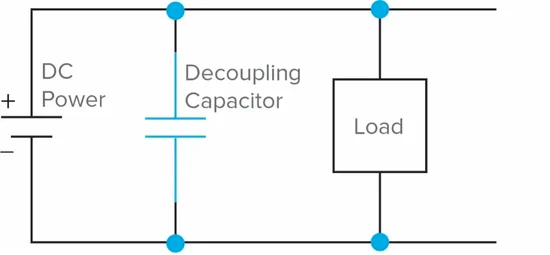As is well known, hnstshop.com/product-list/C-C-p1.html" target="_blank">capacitors play a role in providing local energy storage and stabilizing power supply voltage in electronic circuits. Decoupling capacitors are a special type of capacitor that can isolate or decouple two circuits. In other words, such capacitors can decouple AC signals from DC signals, and vice versa. Decoupling capacitors act like buffers, providing clean and stable power to components, thereby minimizing the risk of faults, noise coupling, and signal integrity issues.
How does a decoupling capacitor work and why is it needed?
Decoupling capacitors are mainly used to suppress voltage fluctuations or noise on power lines, thereby avoiding affecting the operation of sensitive components. In the power supply, decoupling capacitors are placed near the power pins of integrated circuits (ICs) or other sensitive components, which are connected in parallel with the power line and serve as local energy storage devices that can quickly provide or absorb current as needed (Figure 1).

Decoupling capacitors are mainly used to suppress voltage fluctuations or noise on power lines, thereby avoiding affecting the operation of sensitive components. In the power supply, decoupling capacitors are placed near the power pins of integrated circuits (ICs) or other sensitive components, which are connected in parallel with the power line and serve as local energy storage devices that can quickly provide or absorb current as needed (Figure 1).
The benefits of using ceramic capacitors for decoupling
Ceramic capacitors are widely used as decoupling capacitors because they have many advantageous electrical characteristics:
Small size and high capacitance: Ceramic capacitors have small size and high capacitance, which can store enough energy in a smaller packaging memory, which is particularly advantageous in cases of limited PCB space.
Low Equivalent Series Resistance (ESR): The equivalent series resistance (ESR) of ceramic capacitors is very low, which means they can effectively transport or absorb current without significant voltage drop, allowing capacitors to quickly respond to dynamic changes in current demand and provide energy immediately when needed.
Low Equivalent Series Inductance (ESL): Ceramic capacitors typically have a lower equivalent series inductance (ESL), thus providing good high-frequency filtering capability. They can effectively suppress high-frequency noise and provide low impedance paths for high-frequency currents.
Wide frequency response: Ceramic capacitors have a wide frequency response, making them suitable for filtering out various common noise frequencies in power lines.
Temperature stability: Ceramic capacitors can maintain capacitance and performance over a wide temperature range, and can achieve stable decoupling even under different working conditions.
Choose the ideal decoupling ceramic capacitor
In order to choose the most ideal decoupling capacitor, we need to consider many factors, such as appropriate capacitance value, rated voltage, and capacitor type. The professional team of engineers at Huanian Mall is willing to assist you in finding the best solution. We have decades of experience in providing various specialized components (capacitors and other precision electronic components) for power electronic equipment, and we have a deep understanding of the entire electrical system. KPD is willing to work with you to find a suitable technical solution for your application and optimize the performance of decoupling capacitors in power supplies.
For more information on decoupling capacitors, including high reliability broadband components 2 suitable for medium voltage and ultra-high frequency applications, or stacked capacitors with pins suitable for higher voltages, please follow: Hnstshop
